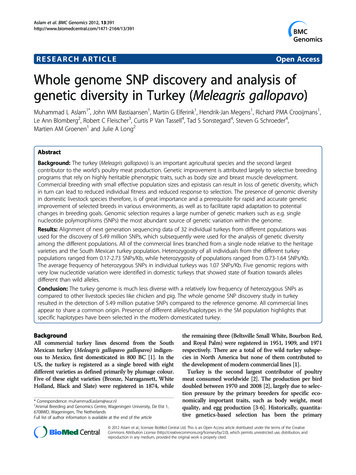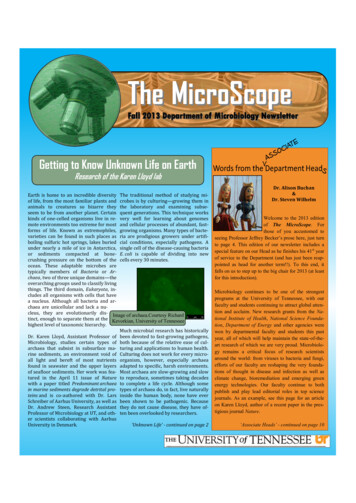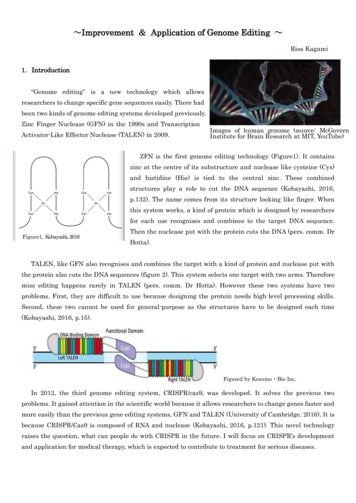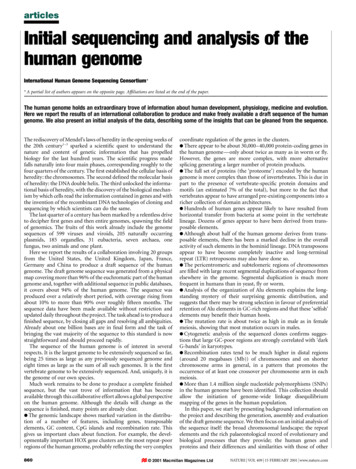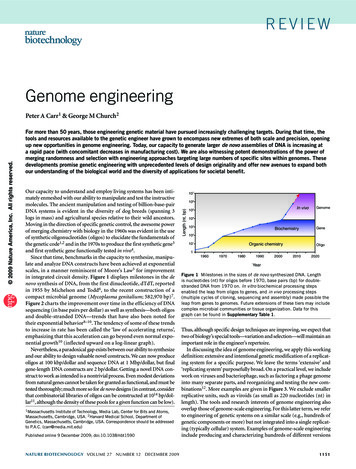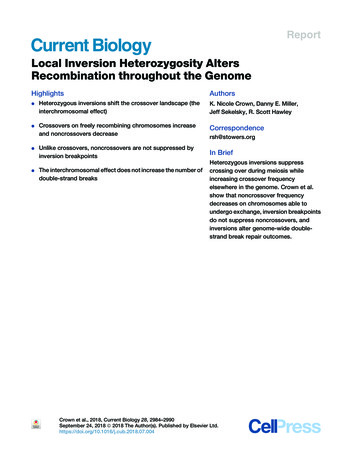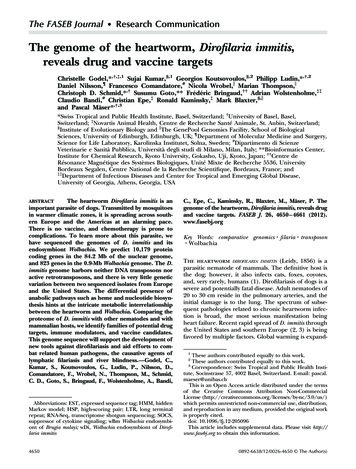
Transcription
The FASEB Journal Research CommunicationThe genome of the heartworm, Dirofilaria immitis,reveals drug and vaccine targetsChristelle Godel,*,†,‡,1 Sujai Kumar,§,1 Georgios Koutsovoulos,§,2 Philipp Ludin,*,†,2Daniel Nilsson,¶ Francesco Comandatore,# Nicola Wrobel,储 Marian Thompson,储Christoph D. Schmid,*,† Susumu Goto,** Frédéric Bringaud,†† Adrian Wolstenholme,‡‡Claudio Bandi,# Christian Epe,‡ Ronald Kaminsky,‡ Mark Blaxter,§,储and Pascal Mäser*,†,3*Swiss Tropical and Public Health Institute, Basel, Switzerland; †University of Basel, Basel,Switzerland; ‡Novartis Animal Health, Centre de Recherche Santé Animale, St. Aubin, Switzerland;§Institute of Evolutionary Biology and 储The GenePool Genomics Facility, School of BiologicalSciences, University of Edinburgh, Edinburgh, UK; ¶Department of Molecular Medicine and Surgery,Science for Life Laboratory, Karolinska Institutet, Solna, Sweden; #Dipartimento di ScienzeVeterinarie e Sanità Pubblica, Università degli studi di Milano, Milan, Italy; **Bioinformatics Center,Institute for Chemical Research, Kyoto University, Gokasho, Uji, Kyoto, Japan; ††Centre deRésonance Magnétique des Systèmes Biologiques, Unité Mixte de Recherche 5536, UniversityBordeaux Segalen, Centre National de la Recherche Scientifique, Bordeaux, France; and‡‡Department of Infectious Diseases and Center for Tropical and Emerging Global Disease,University of Georgia, Athens, Georgia, USAThe heartworm Dirofilaria immitis is animportant parasite of dogs. Transmitted by mosquitoesin warmer climatic zones, it is spreading across southern Europe and the Americas at an alarming pace.There is no vaccine, and chemotherapy is prone tocomplications. To learn more about this parasite, wehave sequenced the genomes of D. immitis and itsendosymbiont Wolbachia. We predict 10,179 proteincoding genes in the 84.2 Mb of the nuclear genome,and 823 genes in the 0.9-Mb Wolbachia genome. The D.immitis genome harbors neither DNA transposons noractive retrotransposons, and there is very little geneticvariation between two sequenced isolates from Europeand the United States. The differential presence ofanabolic pathways such as heme and nucleotide biosynthesis hints at the intricate metabolic interrelationshipbetween the heartworm and Wolbachia. Comparing theproteome of D. immitis with other nematodes and withmammalian hosts, we identify families of potential drugtargets, immune modulators, and vaccine candidates.This genome sequence will support the development ofnew tools against dirofilariasis and aid efforts to combat related human pathogens, the causative agents oflymphatic filariasis and river blindness.—Godel, C.,Kumar, S., Koutsovoulos, G., Ludin, P., Nilsson, D.,Comandatore, F., Wrobel, N., Thompson, M., Schmid,C. D., Goto, S., Bringaud, F., Wolstenholme, A., Bandi,ABSTRACTAbbreviations: EST, expressed sequence tag; HMM, hiddenMarkov model; HSP, high-scoring pair; LTR, long terminalrepeat; RNA-Seq, transcriptome shotgun sequencing; SOCS,suppressor of cytokine signaling; wBm Wolbachia endosymbiont of Brugia malayi; wDi, Wolbachia endosymbiont of Dirofilaria immitis4650C., Epe, C., Kaminsky, R., Blaxter, M., Mäser, P. Thegenome of the heartworm, Dirofilaria immitis, reveals drugand vaccine targets. FASEB J. 26, 4650 – 4661 (2012).www.fasebj.orgKey Words: comparative genomics 䡠 filaria 䡠 transposon䡠 WolbachiaThe heartworm DIROFILARIA IMMITIS (Leidy, 1856) is aparasitic nematode of mammals. The definitive host isthe dog; however, it also infects cats, foxes, coyotes,and, very rarely, humans (1). Dirofilariasis of dogs is asevere and potentially fatal disease. Adult nematodes of20 to 30 cm reside in the pulmonary arteries, and theinitial damage is to the lung. The spectrum of subsequent pathologies related to chronic heartworm infection is broad, the most serious manifestation beingheart failure. Recent rapid spread of D. immitis throughthe United States and southern Europe (2, 3) is beingfavored by multiple factors. Global warming is expand1These authors contributed equally to this work.These authors contributed equally to this work.3Correspondence: Swiss Tropical and Public Health Institute, Socinstrasse 57, 4002 Basel, Switzerland. E-mail: pascal.maeser@unibas.chThis is an Open Access article distributed under the termsof the Creative Commons Attribution Non-CommercialLicense )which permits unrestricted non-commercial use, distribution,and reproduction in any medium, provided the original workis properly cited.doi: 10.1096/fj.12-205096This article includes supplemental data. Please visit http://www.fasebj.org to obtain this information.20892-6638/12/0026-4650 The Author(s)
ing the activity season of vector mosquitoes, increasingtheir abundance and the likelihood of transmission ofthe parasite, and there are growing numbers of pets,reservoir animals, and “traveling” dogs (2, 3).D. immitis is an onchocercid filarial nematode, relatedto important parasites of humans, such as Onchocercavolvulus, the agent of river blindness. The D. immitislifecycle is typical for Onchocercidae. Microfilariae, shedinto the bloodstream by adult females, are ingested by amosquito (various species, including Aedes, Anopheles, andCulex spp.) where they develop into third-stage larvae (L3)and migrate to the labium. Feeding by an infected mosquito introduces L3 into the skin. The prepatent periodin the newly bitten dog is 6 –9 mo, during which theinjected larvae undergo two further molts and migrate viamuscle fibers to the pulmonary vasculature, where theadult nematodes develop. At present, diagnosis is effectiveonly for patent infections, because it is based on detectionof circulating microfilariae or antigens from mature females. Treatment of dirofilariasis is also problematic,because the arsenical melarsomine dihydrochloride, theonly adulticide approved by the U.S. Food and DrugAdministration, can cause adverse neurological reactions.Treatment carries a significant risk of lethality due to blockage of the pulmonary artery by dead nematodes. No vaccineis available. These issues, together with the alarming increasing spread of D. immitis, prompted the American HeartwormSociety to recommend year-round chemoprophylactic treatment of dogs (4) to kill the larval stages before they developinto adults. This requires monthly administration of anthelmintics, predominantly macrocyclic lactones, such as ivermectin, milbemycin, or moxidectin.Human-infective parasites related to D. immitis causesubcutaneous filariasis and river blindness and areendemic in tropical and subtropical regions around theglobe, with an estimated 380 million people affected(5). Improved diagnostics, new drugs, and, ultimately,effective vaccines are sorely needed. The sequencing ofthe Brugia malayi genome provides a platform forrational drug design, but by itself this single sequencecannot distinguish between idiosyncratic and sharedtargets that could be exploited for control (6).Most of the filarial nematodes that cause diseases inhumans and animals, including D. immitis, O. volvulus,Wuchereria bancrofti, and B. malayi, have been shown toharbor intracellular symbiotic bacteria of the genus Wolbachia (e.g., refs. 7–10). These bacteria are vertically transmitted to the nematode progeny, via transovarial transmission. In most of the infected nematode species, allindividuals are infected (reviewed in ref. 11). Eventhough the exact role of Wolbachia in filarial biology hasnot yet been determined, these bacteria are thought to bebeneficial to the nematode host. Indeed, antibiotics thattarget Wolbachia have been shown to have deleteriouseffects on filarial nematodes, blocking reproduction, inducing developmental arrest, and killing adult nematodes(e.g., refs. 7–9). This has led to development of researchprojects with the aim of developing anti-Wolbachia chemotherapy as a novel strategy for the control of filarialdiseases. Wolbachia has also been implicated in the immunoTHE HEARTWORM GENOMEpathogenesis of filarial diseases, with a role in the development of pathological outcomes, such as inflammation andclouding of the cornea that is typical of river blindness (12).The genome of Wolbachia is thus an additional source ofpotential drug targets (7–10), but a single genome cannotreveal shared vs. unique biochemical weaknesses.The human pathogenic Onchocercidae do not represent an attractive market for the pharmacologicalindustry, because projected incomes from impoverished communities in developing endemic nationswould be unlikely to cover the costs of drug development. The heartworm may hold a possible solution tothis problem, because the market potential for novelcanine anthelmintics is big, given the costs for heartworm prevention of 75–100/dog/yr and the estimatednumber of 80 million dogs in the United States (13).Choosing drug targets that are likely to be conserved inrelated, human pathogenic species may benefit bothcanine and human medicine. Here we present the draftgenome sequences of D. immitis and its Wolbachia endosymbiont (wDi) and use these data to investigate therelationship between nematode and endosymbiont andidentify new drug and vaccine targets.MATERIALS AND METHODSD. immitis isolates and DNA sequencingWe sequenced two canine D. immitis isolates, one from Pavia,Italy, and the other from Athens, Georgia, USA. The Paviaisolate was established in a laboratory lifecycle after primaryisolation from an infected dog. Adult Pavia nematodes usedfor DNA extraction were recovered after necropsy of dogsinfected as a control group in ongoing investigations (permitFR401e/08 from the Veterinary Office Canton de Fribourg,Switzerland). The Athens nematodes used for DNA and RNAextraction were from a naturally infected dog necropsied aspart of routine clinical surveillance and were not from anestablished strain. Genomic DNA was extracted (QIAampDNA extraction kit; Qiagen, Valencia, CA, USA) from individual adult female nematodes from Pavia and Athens isolates, and RNA was extracted (RNeasy kit; Qiagen) fromindividual female and male nematodes from Athens. Wholegenome shotgun sequences were generated at The GenePoolGenomics Facility (University of Edinburgh, Edinburgh, UK)and at Fasteris SA (Geneva, Switzerland) using IlluminaGAIIx and HiSeq2000 instruments (Illumina, Inc., San Diego,CA, USA). Several short insert (100- to 400-bp) paired-endamplicon libraries and long insert (3- to 4-kb) mate-pairamplicon libraries were made, and data from four of thesewere used in the final assembly (details are given on the Website http://www.dirofilaria.org). These yielded a raw datatotal of 28 Gb in 295 million reads [European BioinformaticsInstitute (EBI) Short Read Archive, accession numberERA032353; http://www.ebi.ac.uk/ena/]. After trimminglow-quality bases (Phred score 20) and filtering out readswith uncalled bases or length 35 b, 271 million reads wereused for assembly (Supplemental Table S1).Nuclear, mitochondrial, and Wolbachia genome assembliesThe short-read data were assembled using ABySS 1.2.3 (14). Anumber of test assemblies were performed using other assem4651
blers, and a range of parameters was tested within ABySS, andthe final, optimal assembly was performed using a k-merlength of 35 and scaffolding with the paired-end data only.Assembly qualities were assessed using summary statisticsincluding maximizing the N50 (the contig length at which50% of the assembly span was in contigs of that length orgreater), maximum contig length, and total number of basesin contigs (see Supplemental Table S1) and using biologicaloptimality assessment, such as maximizing the coverage ofpublished D. immitis expressed sequence tag (EST) sequencesand maximizing the number of B. malayi genes matched andthe completeness of representation of core eukaryotic genes(using CEGMA; ref. 15). Redundancy due to allelic polymorphism was reduced with CD-HIT-EST (16), merging contigsthat were ⱖ97% identical over the full length of the shortercontig. The mitochondrial genome was assembled by mapping the reads to the published D. immitis mitochondrialgenome (17) and predicting a consensus sequence of themitochondrial genomes of the Athens and Pavia nematodesseparately. The wDi genome was assembled by first identifyinglikely wDi contigs in the whole assembly with BLASTn (18)using all Wolbachia genomes from EMBL-Bank, and thencollecting all raw reads (and their pairs; n 6,912,659) thatmapped to these putative wDi genome fragments. The reduced set of likely wDi reads was then assembled using anindependently optimized ABySS parameter set, using matepair information where available. Mitochondrial and wDicontigs were removed from the full assembly to leave the finalnuclear assembly.Analyses of orthology and divergence in filarial WolbachiaTranscriptome shotgun sequencing (RNA-Seq) assemblyTo identify potential lateral genetic transfers from Wolbachia to the host nuclear genome, the nuclear genome wasqueried against the 921-kbp wDi genome using the dcmegablast option in BLASTN (NCBI-blast 2.2.25) withdefault settings. All high-scoring pairs (HSPs) longer than100 bp with 80% identity were kept. Overlapping HSPcoordinates on the nuclear genome were merged, andsequences from these coordinates were extracted to obtainputative nuclear Wolbachia DNA elements. The B. malayinuclear genome was screened with the B. malayi Wolbachia(wBm) genome in the same way. The small numbers ofWolbachia insertions identified in the nuclear genomes ofAcanthocheilonema viteae and Onchocerca flexuosa (34) weresurveyed for matches to the wDi and wBm genomes andcross-compared with the insertion sets from the completeD. immitis and B. malayi genomes using reciprocal bestBLAST searches and filtering alignments shorter than 100bp. Reciprocal best BLAST matches were isolated andsingle-linkage clustered.The preparation of amplicon libraries and RNA-Seq analysiswere performed following standard Illumina TruSeq protocols. A total of 11,019,886 (male) and 21,643,293 (female)read pairs of length 54 b were produced on the IlluminaGAIIx platform (ArrayExpress accession number E-MTAB714; ENA study accession number ERP000758). After qualityfiltering, the remaining 31,396,183 pairs were assembled withTrans-ABySS using k-mer values from 23 to 47 in steps of 4(Supplemental Table S1).D. immitis nuclear genome protein-coding gene predictionand analysisRepeats in the D. immitis genomic assembly were identifiedand masked using RepeatMasker 3.2.9 (19), including all“Nematoda” repeats in the RepBase libraries (20). TheMAKER 2.08 annotation pipeline (21) was used to identifyprotein-coding genes based on evidence from the RNA-Seqassembly, alignments to the B. malayi proteome (WormBaserelease WS220; http://wormbase.sanger.ac.uk/), predictionsmade by the ab initio gene finder SNAP (22), and predictionsfrom the ab initio gene finder Augustus (23) based on theAugustus hidden Markov model (HMM) profiles for B. malayi. MAKER predicted 11,895 gene models, and, with alternative splicing, a total of 12,872 transcripts and peptides. Wecompared the nuclear proteome of D. immitis with those offour other species for which complete genome data areavailable and which span the phylogenetic diversity of thephylum Nematoda (B. malayi, Ascaris suum, Caenorhabditiselegans, and Trichinella spiralis). The complete proteomes werecompared using all-against-all BLAST, and then clusteredusing OrthoMCL (24). OrthoMCL clusters were postprocessed to classify clusters by their species content and analyzed with reference to the robust molecular phylogeny of theNematoda (25). The prediction of D. immitis orthologs fromB. malayi, C. elegans, Homo sapiens, and Canis lupus to identifydrug targets was performed with InParanoid (26).4652Vol. 26November 2012The wDi genome was annotated with the RAST server (27),an online resource that uses best-practice algorithms toperform both gene finding and gene functional annotation.Selected metabolic pathways were annotated based on enzyme lists from the KEGG Pathway database (28), after anHMM profile was generated for each enzyme (29) from aClustalW (30) multiple alignment of a redundancy-reducedset of all the manually curated entries in UniProt (31).Analysis of orthology was performed using the BLAST reciprocal best-hits algorithm (32), with the following cutoff values: E value 0.1 and ID percentage 60%. Protein distance foreach pair of orthologs was calculated using Protdist in Phylip3.69 (33) with the Dayhoff PAM matrix option. Proteins wereallocated to functional categories using BLAST against theCOG database. Protein distances were then analyzed based onCOG categories: within each category we calculated theaverage distances of protein pairs. To evaluate whether somecategories were significantly more variable than others, weperformed the Kruskal-Wallis test on COG categories containing more than one ortholog pair. The pairwise Mann-Whitneytest was then performed to detect pairs of COG categoriesthat displayed significant differences in their average variation.Identification of Wolbachia insertions in nematodegenomesRESULTSGenome assembly of D. immitis and its WolbachiasymbiontGenome sequence was generated from single individuals of D. immitis isolated from naturally infected dogs,one from Athens, Georgia (USA) and the other fromPavia (Italy). A total of 16 Gb of raw data was retainedafter rigorous quality checks, corresponding to 170fold coverage of the D. immitis nuclear genome (likelyto be 95 Mb, similar to related Onchocercidae). TheABySS (35) assembler performed best based on statistical and biological measures (Supplemental Table S1).The mitochondrial and Wolbachia wDi genomes wereassembled independently. The final nuclear assemblyThe FASEB Journal 䡠 www.fasebj.orgGODEL ET AL.
contained 84.2 Mb of sequence in 31,291 scaffolds withan N50 of 10,584 bases (Table 1). The draft genome ofwDi consists of 2 scaffolds spanning 0.92 Mb. Weidentified 99% of previously deposited genome surveysequences putatively from wDi (GenBank accessionnumbers ET041559 to ET041665) within our wDi assembly. The wDi genome was 16% smaller than that ofwBm (1.08 Mb; GenBank accession number NC 006833),and there was significant breakage of synteny betweenthe two genomes, as has been observed between otherWolbachia.The D. immitis and wDi genomes, the annotations wehave made on these, and additional technical detailsand analyses are available through a dedicated genomebrowser (http://www.dirofilaria.org).Lack of genetic diversity between the sequenced D.immitis isolatesEven though the two sequenced D. immitis came fromindependent isolates from different continents, theyshowed low genetic differentiation, allowing the rawsequencing data from both nematodes to be coassembled. We mapped the reads from each nematodeback to the draft assembly and identified only 32,729high-quality single-nucleotide variations, a very lowper-nucleotide diversity rate of 0.04%. We identifiedthe sequences corresponding to 11 polymorphicmicrosatellite loci used previously to analyze the D.immitis population structure in North America (36)and genotyped our two isolates in silico by countingthe predicted numbers of microsatellite repeats ateach locus. Both our nematodes could be classifiedwithin the diversity of the eastern United Statespopulation. The mitochondrial genomes of the twoisolates differed at only 6 sites (and were thus 99.9% identical). Surprisingly, compared with thepublished, Australian D. immitis mitochondrion (17),both had many shared differences (each was only99.5% identical to the published D. immitis mitochondrion). Because the 70 differences were oftenclumped and were unique in the published D. immitisTABLE 1. Comparison of the genome assemblies of D. immitis,B. malayi, and C. elegansCharacteristicD. immitisB. malayiC. elegansAssembly size (Mb)84.293.6a100.3Protein-coding gene models 11,37511,43420,517Genes per megabase135122205Predicted proteins12,34411,46031,249Protein-coding sequence (%)18.013.825.4Median exons per gene556Median exon size (b)142139147Median intron size (b)22621373Overall GC content (%)28.330.235.4Exon GC content (%)37.439.443.4Intron GC content (%)26.627.232.5B. malayi data are from the GenBank RefSeq dataset; C. elegansdata from the WS230 dataset. a70.8 Mb scaffolds 17.5 Mb shortcontigs.THE HEARTWORM GENOMEmitochondrial genome compared both with our twogenomes and with the genomes of five other filarialnematodes, we suggest that many of these are sequencing errors in the published genome.A metazoan genome without active transposableelementsThe D. immitis genome was surveyed for the three mainclasses of transposable elements [DNA transposons,long terminal repeat (LTR) retrotransposons, and nonLTR retrotransposons] with tBLASTn (18) using thetransposon-encoded proteins as queries. No traces ofactive or pseudogenized DNA transposons or non-LTRretrotransposons were found, but 376 fragments ofLTR retrotransposons of the BEL/Pao family (37) wereidentified. None of these fragments were predicted tobe functional, because all contained frame shifts andstop codons in the likely coding sequence. The D.immitis Pao pseudogenes were most similar to Paofamily retrotransposons from B. malayi (6). In B. malayi,several of the Pao retrotransposons are likely to beactive, because they have complete open readingframes and LTRs. Overall, however, B. malayi has alower density of Pao elements and fragments (3.4Pao/Mb, 8.3% of which are predicted to be functionally intact) compared with D. immitis (4.6 Pao/Mb,none of which were intact).D. immitis nuclear proteomeProtein coding genes were predicted in the nuclearassembly using the MAKER pipeline (21), integratingevidence-based (RNA-Seq and known protein mapping) and ab initio methods. Of the 11,375 genemodels, 897 were predicted to generate alternatetranscripts (Table 1). The total number of predictedproteins of length ⱖ100 aa was 10,179, similar to the9807 predicted in B. malayi. Based on matches to D.immitis ESTs and core eukaryotic genes (15), the D.immitis proteome was likely to be near-complete.Protein-coding exons occupy 18% of the genomeof D. immitis and 14% of the genome of B. malayi(Table 1), but in C. elegans there are nearly twice asmany genes, and exons cover 30% of the genome.The median global identity between a D. immitisprotein and its best match (as determined byBLASTp) in B. malayi was 75%.D. immitis proteins were clustered with the complete proteomes of four other nematode species.These clusters were classified and mapped onto thephylogenetic tree of the five species based on theplacement of the deepest node that linked the species that contributed members (Fig. 1). The D.immitis proteome included 3199 proteins (31% of thetotal proteome) that were unique to this species, aproportion similar to that found in B. malayi (27%),but many fewer (and a lower proportion) comparedwith those for the other species (for example, C.elegans had 63% of its proteome in species-unique4653
A Dirofilaria immitis protein classification1062Figure 1. Conserved and novel genes in D.immitis. The D. immitis proteome was clusteredwith those of B. malayi, A. suum, C. elegans, andT. spiralis. Clusters were then classified basedon the membership from the five species according to the current phylogeny of the phylum Nematoda. A) Pie chart showing the distribution of classification of D. immitis proteins: D.immitis only, singletons and clusters only foundin D. immitis; Onchocercidae, clusters withmembers only from D. immitis and B. malayi;Spiruria, clusters with members only from Onchocercidae and A. suum; Rhabditia clusterswith members only from Spiruria and C. elegans;Nematoda, clusters with members from all fivespecies (i.e., Rhabditia and T. spiralis); andother patterns, clusters with members not fitting simply into the phylogenetic schema(probably arising from gene loss, lack of predictions, or failure to cluster in one or morespecies). B) Cluster numbers and patterns ofconservation mapped onto the phylogeny ofthe five species.3199Dirofilaria immitis onlyOnchocercidaeSpiruriaRhabditiaNematoda (all)other patterns3941948Trichinella spiralis (T)10,950 species-unique8902304Ascaris suum (A)8,995 species-uniqueNode cNode aNode bNode dDirofilaria immitis (D)3,199 species-uniqueBrugia malayi (B)2,679 species-uniqueNode aCaenorhabditis elegans (C)12,917 species-uniqueNode bNode cNode dA B C D T (3042)A B C T (192)A C D T (126)B C D T (61)B D T (22)B T (18)A B T (15)B C T (6)A C T (233)A B D T (128)A T (64)C T (50)D T (21)A D T (16)C D T (9)A B D (775)A D (196)A B (193)B D (850)A B C D (1933)A C (995)A C D (226)A B C (217)B C D (115)B C (50)C D (26)B Cluster origins mapped onto nematode phylogenyclusters). This difference may be partly due to the850 proteins in clusters uniquely shared by therelatively closely related D. immitis and B. malayi, butthese clusters only raise the proportion of proteins inphylogenetically local clusters to 47%.D. immitis genes homologous to known antinematodedrug targetsAn array of drugs are effective against nematode parasites(Table 2). Of these, flubendazole (38), mebendazoleTABLE 2. Candidate drug targets, top-down search: current anthelmintics and their known targets in C. elegans and orthologs in D.immitisChemical eMebendazoleLevamisoleImidazothiazoleMacrocyclic lactoneIvermectinMilbemycinMoxidectinSelamectinC. elegans -TubulinBEN-1nACh CR-23DES-2Glutamate receptorGABA receptorCyclodepsipeptideEmodepsideK channelLatrophilin GPCRAminoacetonitrile derivativeMonepantelnACh receptorD. 10DIMM25280, 7270, DIMM37275DIMM17690nAChR, nicotinic acetylcholine; GPCR, G protein-coupled receptor.4654Vol. 26November 2012The FASEB Journal 䡠 www.fasebj.orgGODEL ET AL.
(39), levamisole (40), ivermectin, milbemycin, moxidectin, and selamectin (41, 42) have been demonstrated tobe active against D. immitis. Many drug targets have beenidentified, particularly through forward genetics in themodel nematode C. elegans (43) (Table 2). Prominentamong these targets are neuronal membrane proteins,highlighting the importance of the neuromuscular junction as a hotspot of anthelmintic drug action. D. immitisappears to lack some known targets, notably members ofthe DEG-3 subfamily of acetylcholine receptors, whichcontains the presumed targets of monepantel (44). Thiscontrasts with B. malayi, which possesses orthologs of DEG-3and DES-2 (45). In C. elegans, the target space oflevamisole and ivermectin comprises a large number ofligand-gated ion channels. Although these drugs areeffective against heartworm, some of these ion channelsdo not have an ortholog in D. immitis (Table 2),indicating that those present are sufficient to conferdrug susceptibility. The identified D. immitis orthologsof the known anthelmintic targets can now be monitored in suspected cases of drug resistance.New drug target candidates in D. immitisNew potential drug targets were identified in silicothrough an exclusion-inclusion strategy (46, 47). Start-ing from the complete set of predicted D. immitisproteins, we excluded proteins that had an ortholog inthe dog or human proteome or had multiple paralogsin D. immitis. We included proteins that had a C. elegansortholog essential for survival or development (basedon RNAi phenotypes) and had predicted function as anenzyme or receptor. Among the 20 candidates identified (Table 3) were several proven drug targets, such asRNA-dependent RNA polymerase (antiviral), apurinic/apyrimidinic endonuclease and hedgehog proteins (anticancer; ref. 48), UDP-galactopyranose mutase (againstmycobacteria, ref. 49; and kinetoplastids, ref. 50), sterol-C24-methyltransferase (antifungal; ref. 51), and theinsecticide target chitin synthase (52). The D. immitisorthologs of these enzymes may serve as starting pointsfor the development of new anthelmintics.Immune modulators and vaccine candidatesFilarial nematodes modulate the immune systems oftheir mammalian hosts to promote their own survivaland fecundity, but the exact mechanisms used remainenigmatic. Proteases such as leucyl aminopeptidase andprotease inhibitors such as serpins and cystatins havebeen implicated in disruption of immune signal processing (53), and we identified D. immitis leucyl amino-TABLE 3. Candidate drug targets, bottom-up searchD. immitis proteinNucleic acid synthesisand repairDIMM09370DIMM23395Glycosylation 6945Lipid 21065Signal ed functionB. malayi orthologH. sapienslog10 (E)C. lupuslog10 (E)C. elegans RNAiRNA-dependent RNA polymeraseApurinic/apyrimidinic endonucleaseBM06623BM171510.28 10.11 e -1,4-MannosyltransferaseUDP-galactopyranose mutaseChitin , BM027790.950.36 3.520.940.08 4.00LethalMolt defectiveLethalLipaseSterol-C24-methyltransferase (Erg11)MethyltransferaseBM01258, BM03783BM20515BM188890.08 3.10 0.03 1.60 4.00 0.15LethalLethalLethalAquaporinBM04673 2.05 0.52Lethal 2.40 1.06 1.26 2.70 1 1 1 4.52 0.59 1.57 alLethal 3.22 4.00Lethal0.77 1.02LethalNuclear hormone receptorG protein-coupled receptorG protein-coupled receptorG protein-coupled receptorGroundhog proteinWarthog proteinWarthog proteinHaloacid dehalogenase-likehydrolaseApoptosis regulator CED-9BM19106BM01098BM01043, BM17326,BM08657BM19541BM01838Potential drug targets were filtered from the predicted D. immitis proteome using the following criteria: 1) presence of an ortholog in C.elegans that
The FASEB Journal Research Communication The genome of the heartworm, Dirofilaria immitis, reveals drug and vaccine targets Christelle Godel,*,†,‡,1 Sujai .


